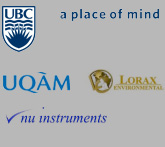 Priyanka Chandan
Priyanka Chandan
PhD graduate
University of Toronto
I am a Ph.D. student under the supervision of Dr. Bridget A. Bergquist at the University of Toronto. The focus of my research is understanding the biogeochemical cycles of various trace metals and the application of their isotope systems. More specifically, I have been working on understanding the mercury (Hg) biogeochemical cycle and developing stable Hg isotopes as a tracer tool to understand and quantify Hg sources and cycling in the natural systems. I received my Masters in Applied Science in September 2011 at the University of Toronto under the supervision of Dr. Bridget A. Bergquist. My M.A.Sc. work quantified Hg isotope fractionation during aqueous Hg photochemical reduction in laboratory experiments. This work was published in Environmental Science and Technology, and demonstrated the way in which organic ligand binding affected Hg isotope fractionation and signatures during laboratory photoreduction experiments.
In my Ph.D., I continued my work on Hg by assessing the use of stable Hg isotopes in natural ecosystems. I investigated the freshwater and marine food webs to assess bioavailable Hg pools in the Hg impacted aquatic ecosystems and trace these pools of Hg in food web organisms. I found that the Hg isotopic signatures are preserved in a predictable way in food webs such that the degree of photoreduction in natural systems can be quantified, and also the contribution of anthropogenic Hg source emissions to the Hg burden in biota can be identified. I also investigated the atmospheric derived Hg and Hg in snow in the Arctic to understand the complicated Hg sources and transformations in the Arctic ecosystem. In my last year, I am now working with Geosyntec Inc. in Canada to develop Hg isotopes as a monitoring tool to assess bioavailable Hg pools in Hg contaminated systems and whether certain mitigation tools are working to lower the Hg burden within these systems. Having a tool that identifies what pools of Hg in an ecosystem are entering the food webs is needed in many sites within Canada where Hg in biota is a problem and where development projects may change the way Hg is cycled (e.g. hydro development).
Last updated May 2018


 Catherine Armstrong
Catherine Armstrong Laura Bilenker
Laura Bilenker Priyanka Chandan
Priyanka Chandan Carol Cheyne
Carol Cheyne June Cho
June Cho Sarina Cotroneo
Sarina Cotroneo Jamie Cutts
Jamie Cutts Fiona D'Arcy
Fiona D'Arcy Ashley Davidson
Ashley Davidson Nicolas Estrade
Nicolas Estrade Anaïs Fourny
Anaïs Fourny Evelyn Frères
Evelyn Frères Elizabeth King
Elizabeth King Alexander Lemieux
Alexander Lemieux Miling Li
Miling Li Marc-Antoine Longpré
Marc-Antoine Longpré Gregor Lucic
Gregor Lucic Kalina Malowany
Kalina Malowany Eduardo Mansur
Eduardo Mansur Jill McDermott
Jill McDermott Rhy McMillan
Rhy McMillan Aleksandra Mloszewska
Aleksandra Mloszewska Nichole Moerhuis
Nichole Moerhuis Emily Mullen
Emily Mullen Genna Patton
Genna Patton Jean-David Pelletier
Jean-David Pelletier Elizabeth Phillips
Elizabeth Phillips Nabila Rahman
Nabila Rahman Lindsay Reynolds
Lindsay Reynolds Luiz Felipe Salim Amaral
Luiz Felipe Salim Amaral Cheyenne Sica
Cheyenne Sica Elliott Skierszkan
Elliott Skierszkan Kate Smith
Kate Smith Natalie Szponar
Natalie Szponar Victoria Tweedie
Victoria Tweedie Tom Ver Hoeve
Tom Ver Hoeve Clara Waelkens
Clara Waelkens Nicole Williamson
Nicole Williamson Anne Wozney
Anne Wozney Wang Zheng
Wang Zheng


 Site by Sprout Creative
Site by Sprout Creative